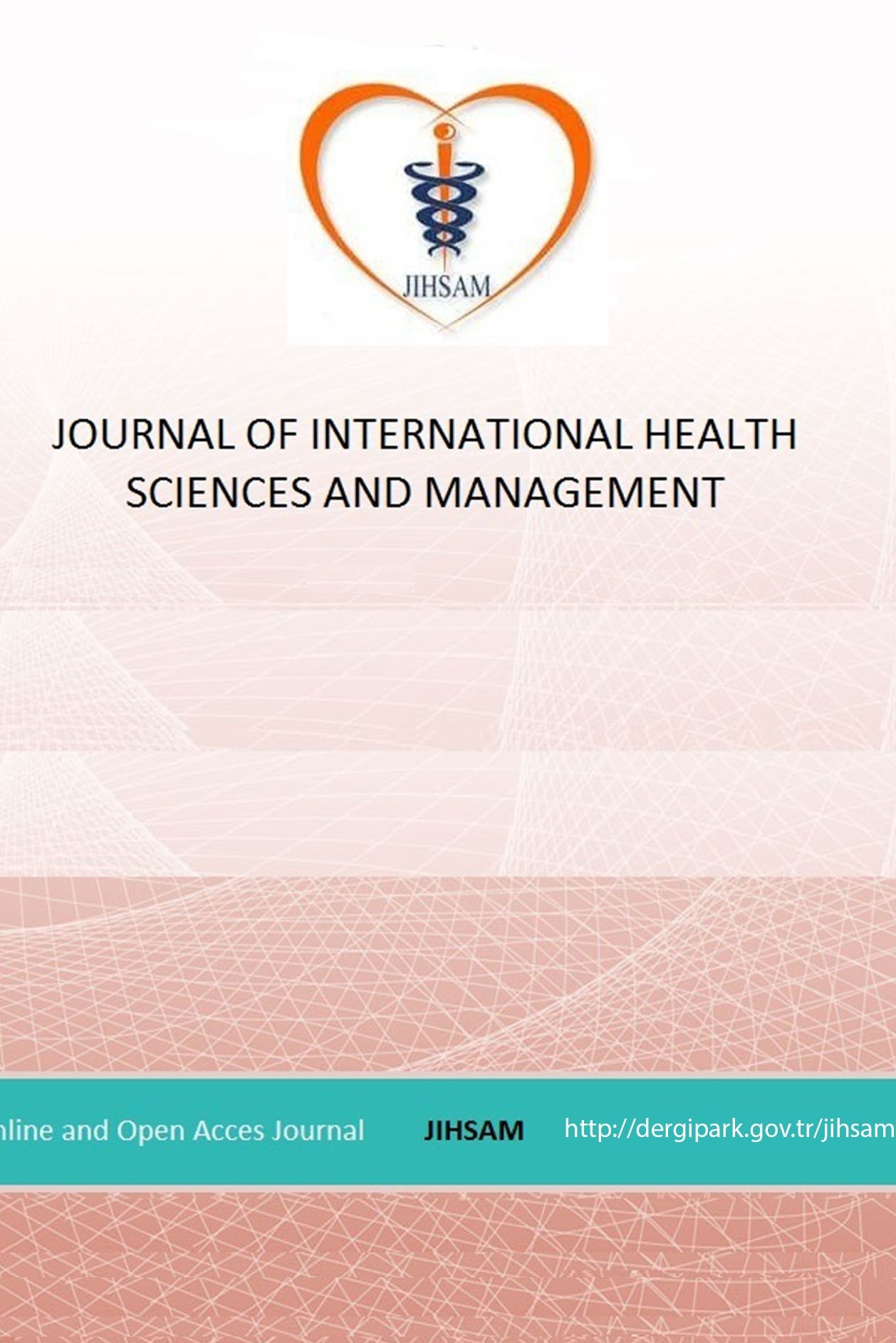MEASUREMENT OF THE EFFECTS OF BUSINESS INTELLIGENCE APPLICATIONS ON PERFORMANCE IN HOSPITALS ACCORDING TO THE MANAGERIAL LEVELS: A CHAIN HOSPITAL APPLICATION
MEASUREMENT OF THE EFFECTS OF BUSINESS INTELLIGENCE APPLICATIONS ON PERFORMANCE IN HOSPITALS ACCORDING TO THE MANAGERIAL LEVELS: A CHAIN HOSPITAL APPLICATION
Business Inteligence, Big Data, Corporate Performance Management,
___
- Willcocks, L.P., Sauer, C. and Lacity, M.C (2016). “Enacting Research Method in Information Systems:Volume 3”, Springer ISBN: 9783319292724.
- Ashrafi, N., Kelleher, L., & Kuilboer, J-P. (2014). ”The impact of business intelligence on healthcare delivery in the USA" Interdisciplinary Journal of Information, Knowledge, and Management, Vol. 9, pp. 117-130, (2014).
- Blind, A. (2012). “Four-layer Data Model Implementation for Business Intelligence”, Thesis Study, (2012).
- Özdoğan, O., (2016). “Büyük Veri Denizi”, (1st Edition), Elma Yayınevi, ISBN: 9786059367059.
- Ki, P.Y., Sawy, E., Omar, A. and Peer, F., (2017). "The Role of Business Intelligence and Communication Technologies in Organizational Agility: A Configurational Approach," Journal of the Association for Information Systems: http://doi.org/10.17705/1jais.00467.
- Schultz, N.O., Collins, A.B. & McCulloch, M., (1994). “The ethics of business intelligence”, Journal of Business Ethics https://doi.org/10.1007/BF00871677. Ivan, M. and Velicanu, M.,(2015). “Healthcare Industry Improvement with Business Intelligence”, Informatica Economica, https://doi.org/10.12948/issn14531305/19.2.2015.08.
- Vest, J.R., Grannis, S.J., Haut D.P., Halverson P.K. and Menachemi N., (2017). “Using structured and unstructured data to identify patients’ need for services that address the social determinants of health”, International Journal of Medical Informatics, Vol. 107, pp.101-106, (2017).
- Jothia, N., Aini, N., Rashidb, A. and Husai, W., (2015). “Data Mining in Healthcare – A Review”, (2015), Procedia Computer Science, https://doi.org/10.1016/j.procs.2015.12.145.
- Iatan, I.F., (2016). “Issues in the Use of Neural Networks in Information Retrieval”, Springer, ISBN: 9783319438702
- Kudyba, S. and Hoptroff R, (2001). “Data Mining and Business Intelligence A Guide to Productivity”, IGI Global, ISBN:9781930708808
- Kao, Y. H., Yu, C.M., Masud, M., Wu, W.H., Chen, L.J., Chun, Y. and Wu J., (2016). “Design and evaluation of hospital-based business intelligence system (HBIS): A foundation for design science research methodology”, Computers in Human Behaviour, https://doi.org/10.1016/j.chb.2016.04.021.
- Richards, G., Yeoh, W., Chong, A.Y.L and Popovic, A, (2017). “ Business Intelligence Effectiveness and Corporate Performance Management: An Empirical Analysis”, Journal of Computer Information Systems https://doi.org/10.1080/08874417.2017.1334244
- Dwivedi, A., Niranjan, M., and Sahu, K., (2013). “A Business Intelligence Technique for Forecasting the Automobile Sales using Adaptive Intelligent Systems (ANFIS and ANN)”, International Journal of Computer Applications, Vol. 74, No: 9, pp. 7-13, (2013).
- Dinçerden, E., (2017). “İş Zekası ve Stratejik Yönetim”, 1st Edition, Beta Yayınları
- Olszak, C. M., (2016). “Toward Better Understanding and Use of Business Intelligence in Organizations”, Information Systems Management, https://doi.org/10.1080/10580530.2016.1155946
- Gök, M, Akçetin, E. and Çelik, U., (2017). “Rapıdmıner ile Uygulmalı Veri Madenciliği”, 1st Edition, Pusula Yayıncılık.
- Parida, A., Kumar, U., Galar, D. and Stenström, C., (2015). "Performance measurement and management for maintenance: a literature review", Journal of Quality in Maintenance Engineering, Vol. 21 Iss 1 pp.
- Kowalczyk, M., (2017). “The Support of Decision Processes with Business Intelligence and Analytics”, Springer, ISBN : 9783658192297
- Muehlen, M., and Shapiro, R., (2014). “Business Process Analytics”, Springer, Handbook on Business Process Management 2, ISBN: 9783642019821.
- Amayri, M., Arora, A., Ploix, S., et all, (2016). “Estimating occupancy in heterogeneous sensor enviorment”, Energy and Buildings, https://doi.org/10.1016/j.enbuild.2016.07.026
- Babiceanu, R.F. and Seker, R., (2016). “ Big Data and virtualization for manufacturing cyber-physical systems: A survey of the current status and future outlook”, Computers in Industry, https://doi.org/10.1016/j.compind.2016.02.004
- Shim, J.P., Warkentin, M., Courtney, J. F. et all. (2002). “Past, present, and future of decision support technology”, Decision Support System, Vol. 33, Issue2, pp.111-126, (2002).
- Yeaoh, W., Popovic, A., (2015). “Extending the understanding of critical success factors for implementing business intelligence systems”, JASIST, https://doi.org/10.1002/asi.23366
- Kaklauskas, A., (2015). “Intelligent Decision Support Systems”, Springer, ISBN: 9783319136585
- Intezari, A., and Gressel, S., (2017). “Information and reformation in KM systems: big data and strategic decision making”, Journal of Knowledge Management, Vol. 21, No.1, pp. 71-91, (2017).
- Duan, L., Xiong, Y., (2015). “Big data analytics and business analytics”, Journal of Management Analaytics, Vol. 2, Issue 1.
- Brooks, P., Gayar, O. E, and Sarnikar, S, (2015). “A framework for developing a domain specific business intelligence maturity model: Application to health care”, International Journal of Information Management, Vol. 35, pp. 337-345.
- Şeker, Ş.A. (2013). İş Zekası ve Veri Madenciliği Weka İle, 1. Baskı, Cinius Yayınları, 2013.
- Wang, Y, Hajli, N. (2016). “Exploring the Path to Big Data Analytics Success in Healthcare’’, Journal of Business Research, 2016. Işık, F. (2016). ‘’Busıness Intellıgence Requırement Analysıs ın Small and Medıum Enterprıses a Masters Thesis (Tez). Atılım Üniversitesi, Endüstri Mühendisliği Ana Bilim Dalı Uzmanlık Tezi; 2016.
- Najah, R., Rahman, N.R. (2017). ‘’Bilgi Sistemlerinin Performans Değerlemeye Etkisi: Sanayi İşletmeleri Araştırması (Tez). Selçuk Üniversitesi, Sosyal Bilimler Enstitüsü İşletme Anabilim Dalı Yönetim Organizasyon Bilim Dalı Uzmanlık Tezi; 2017.
- Özçam, Y, Çoşkun, E. (2016). “Türkiye’de Faaliyet Gösteren İşletmelerin İş Zekası Kullanım Düzeylerinin İncelenmesi Üzerine Bir Araştırma’’, Aksaray Üniversitesi İktisadi ve İdari Bilimler Fakültesi Dergisi, 2016, 8(1): 73-81.
- Yayın Aralığı: Yılda 2 Sayı
- Başlangıç: 2015
- Yayıncı: Sedat BOSTAN
ANALYSIS OF SOME CONCEPTS RELATED TO THE ENVIRONMENT AND HEALTH WITH THE N-GRAM METHOD
Ali ÇİFTÇİ, Alaaddin VURAL, Mustafa Nuri URAL
Effect of health education about personal hygiene on student’s health in primary school
Amira BOSHRA, Abdalbasit MARIOD
Mustafa IŞIK, Onur YARAR, Didem SÖYLEMEZ SUR
EVALUATION OF THE SOCIOECONOMIC STATUS IN THE COVID-19 PANDEMIC PROCESS
Yunus Emre ÖZTÜRK, Hilal AKMAN DÖMBEKCİ, Müjdat YEŞİLDAL
Esendal GÜLEÇ, Kadriye SÖNMEZ, Suat PEKER, İbrahim Halil CANKUL
THE PERCEPTIONS OF NURSES ABOUT PATIENT SAFETY CULTURE: AN EXAMPLE PROVINCE IN NORTH EAST OF TURKEY
Aysun BAYRAM, Afife YURTTAŞ, Mağfiret KARA KAŞIKÇI
The Assessment of Turkey’s Lack of Resilience to Disasters and Hazards with IDB Indicator System
Ünal YAPRAK, Turgut ŞAHİNÖZ, Saime ŞAHİNÖZ
DOES BUSİNESS SATİSFACTİON AFFECT THE LİFE SATİSFACTİON? EXAMPLE OF HEALTH SCİENCES ACADEMİCS
